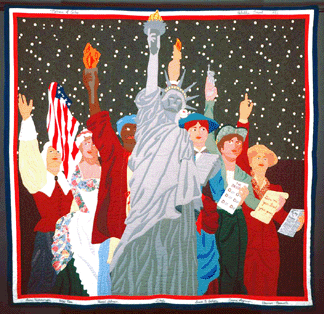What do palmetto trees, rattlesnakes and the Statue of Liberty have in common? The answer is revealed with a visit to “American Visions of Liberty & Freedom,” on view at the National Heritage Museum, July 1 to October 15. The exhibition shows how generations of Americans from Revolutionary times to the present, have drawn, carved and quilted symbols to represent their sometimes-conflicting definitions of liberty and freedom. Among the more than 200 objects in the exhibition are icons such as the Statue of Liberty, Uncle Sam and the American flag that have been revived, revised, reviled or reinterpreted to express the concerns of succeeding generations. For example, following the September 11, 2001, attacks, all US Navy vessels were ordered to fly the Navy’s original red and white striped naval jack bearing a rattlesnake and the words “Don’t Tread On Me.” This was the jack used in the Revolutionary War, and its use was revived as a symbol of the nation’s traditional resolve. The flag on view in the exhibition was flown aboard the USS Nashville during Operation Iraqi Freedom. Similarly, the palmetto tree, a Revolutionary War symbol of South Carolina’s resistance to the British, reappeared during the secession movement of 1860-1861. The first exhibition section, “E Pluribus Unum,” deals with the mounting protest against British policies, such as the Stamp Act, Townshend Acts and Tea Act. Regional symbols of resistance, like the backwoods rattlesnake symbol, spread throughout the nation. After the war, the new nation realized it needed unifying symbols for the nation’s varying interpretations of liberty and freedom. Important objects in this section are a Liberty Tree powder horn; a 1790 cotton textile panel called “The Apotheosis of Franklin”; and a rare silver badge from the African American “Bucks of America,” a Massachusetts Revolutionary War unit composed of former slaves. “A New Birth of Freedom” deals with the place of AfricanAmericans in American society, terminating in civil war. Theabolitionist movement, secession movement, Confederacy and Unioneach had its own symbols. The hammer of an 1863 rifle is cast inthe shape of President Abraham Lincoln’s head, and a whale’s toothis incised with a picture of a member of the United States ColoredTroops. An African American in his country’s uniform, bearing aweapon, was a powerful symbol of freedom, especially to blackAmericans. “The Golden Door” focuses on issues of economic justice from the unveiling of the Statue of Liberty in 1886 to the New Deal to the globalization issues of today. Section Four, “Freedom Now!,” shows the symbols invented by Twentieth Century social movements, including the women’s suffrage and civil rights movements and how liberty and freedom are invoked by both sides on some of today’s issues. The final section, “To Make the World Safe for Democracy,” examines the tension between liberty and security in wartime, from the Spanish American War to the war against terrorism. The exhibition is funded by the National Endowment for the Humanities and organized by the Virginia Historical Society with additional support from the E. Rhodes and Leona B. Carpenter Foundation and the Lettie Pate Whitehead Evans Changing Exhibitions Fund. The National Heritage Museum is at 33 Marrett Road. For information, 781-861-6559 or www.monh.org.
03 Jul 2006 / 0 Comment
‘American Visions Of Liberty & Freedom’ To Open July 1
Published: July 3, 2006
The Statue of Liberty stands with six women in this “Mother of Exiles” quilt by Rebekka Seigel of Owenton, Ky. Left to right, they are Anne Hutchinson, who challenged the Puritan establishment in Massachusetts; Betsy Ross, who probably contributed part of the design of the US flag; Harriet Tubman, who led escaped slaves to freedom; Susan B. Anthony, who fought for women’s voting rights; Emma Lazarus, who wrote the poem “The New Colossus” that linked the statue to immigrants’ hopes; and First Lady Eleanor Roosevelt, who helped draft the UN Declaration of Human Rights. Courtesy Phyllis George.

Antiques and The Arts Weekly is the nation’s leading weekly publication on the antiques and the arts trade, and is available both in print and online.
Each issue average between 100-200 pages and includes reporting on auctions, antiques shows and the arts while providing a platform for both buying and selling.
We have been providing breaking news and important information on the world of antiques and the arts since Publisher R. Scudder Smith started Antiques and The Arts Weekly back in 1963.
Contact
LOCATED AT:
5 Church Hill Road / Newtown, CT 06470
HOURS:
Mon - Fri / 8:00 am - 5:01 pm
PHONE:
(203) 426-8036
